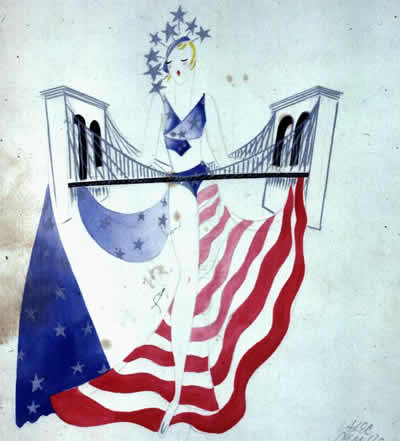 |
 |
 |
|
 |
"The Brooklyn Bridge" is a costume sketch by British theatrical designer Alex Shanks. Designed for the Music Halls of Paris between World wars I and II, this sketch is among some 6,000 designs by 26 known designers including Freddy Wittop, George Barbier, and the great Erté. This Paris Music Hall Collection is considered a centerpiece of the Hargrett Rare Books and Manuscripts Library at the University of Georgia. Photo/ Courtesy Hargrett Rare Books & Manuscripts Library / University of Georgia Libraries
|
|
|
USITT's 21st Century
Initiative: The
Bridge Model
USITT is looking forward to June 20, 2008 when McCarthy Arts Consulting (MAC) will present to the USITT 21st Century Task Force its final report. This report will include exciting plans for improvement and suggest manageable goals, strategic initiatives, and action items to pave the way to a brilliant 50th birthday and lead the organization into a robust new half-century. The genesis of this external assessment of USITT was the Board of Directors Retreat in October 2006 entitled USITT in the 21st Century: Vital, Visible, Sustainable, Marketable, and Innovative. Concern for USITT's future brought together staff, contractors, and committee members, who developed White Papers calling for significant change for USITT as we strive to adjust our organization in ways that anticipate the transforming world and the resulting needs of our profession in the 21st Century. A summit to consider the White Papers, in January 2007, determined that, while many of the ideas presented were not new, embracing them, for a variety of reasons, has eluded USITT. Thus, to move these valuable ideas forward and to help avoid that inevitable stumbling block, "That's the way we've always done it," the Summit participants recommended, and the Executive Committee concurred, that an external professional arts organization assessment would be useful. MAC was chosen to "provide a big picture perspective and solution-based strategies that allow non-profit arts and cultural organizations to clearly define and meet planning, research, and communication goals and objectives," in a year-long appraisal and future planning for USITT. Taskforce members are: Bill Byrnes, Task Force Director, Dean of Fine Arts at Southern Utah University, Past President and Fellow of USITT, and author of Management and the Arts, a textbook widely used and now in the third edition. Carol Carrigan, Administrative & Finance Manager, USITT Carl Lefko, Chairperson and Professor, Department of Theatre and Cinema, Radford University and USITT VP Programming and President-Elect Lea Asbell-Swanger, Assistant Director of the Center for the Performing Arts, Pennsylvania State University, USITT Management Vice-Commissioner for Programming and a member of USITT's Board of Directors Tom Young, Vice President of Marketing for J.R. Clancy, Inc. and member of USITT's Finance Committee Lawrence J. Hill, Professor Emeritus, Western Carolina University, Past Treasurer, Advancement Committee Chair, and Fellow of USITT Travis DeCastro, B.F.A. Stage Management Program Head, School of Theatre, Pennsylvania State University; and USITT Treasurer Sylvia Hillyard Pannell, Professor Emerita, University of Georgia and President, USITT MAC is now eight months into an intense and comprehensive review and assessment of USITT. At the USITT Annual Conference & Stage Expo in Houston in March 2008, Kerry McCarthy and Helene Blieberg of McCarthy Arts Consulting, together with Task Force Director Byrnes and the Board of Directors discussed plans and directions that are emerging from their study of our organization which included researching USITT's nearly 50-year history, focus groups with frequent and occasional users, electronic surveys of members and lapsed members, an analysis of six comparable organizational models, and group and individual interviews with internal and external people engaged with USITT. After much study and discussion, MAC and the Task Force evolved "The Bridge Model" -- a shift toward defining ourselves as the organization that provides the bridge between the education and entertainment industries. This model will provide a centerpiece for USITT as we strive for growth, improved efficiency, and relevance in this rapidly changing world. Highlights of the proposed Bridge Model follow: The Bridge Model:
McCarthy Arts Consulting and USITT's 21st Century Task Force will meet again in June 2008 to study the final report, which will be forwarded to the USITT Board of Directors soon thereafter for consideration, and to make plans for implementation. We are looking forward to a final mapping of strategic directions for USITT as we prepare to make courageous decisions, changes, and build new bridges to the community of theatre and entertainment designers and technologists of the 21st Century. |
||